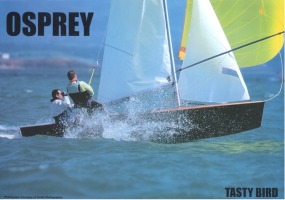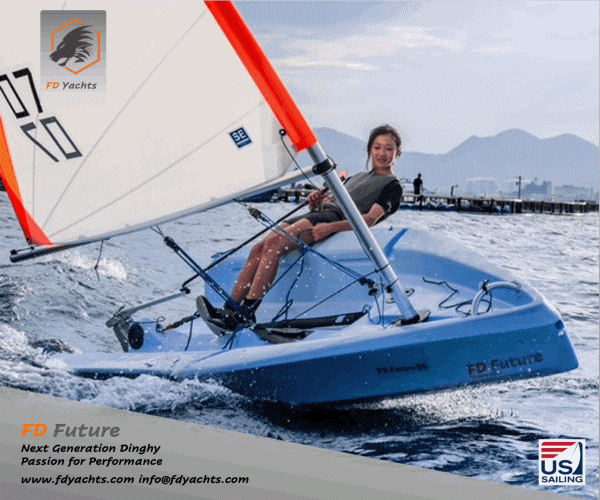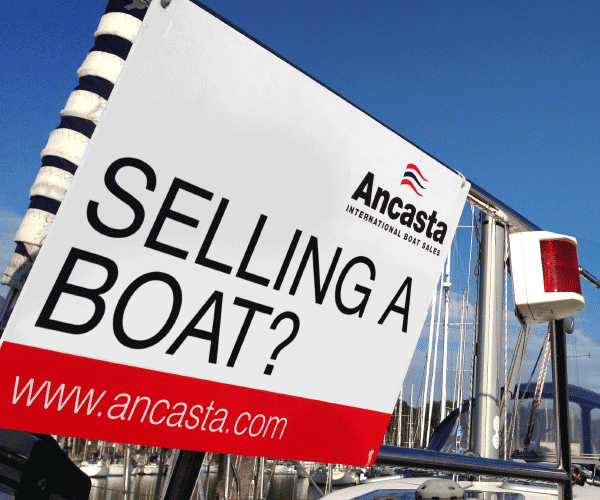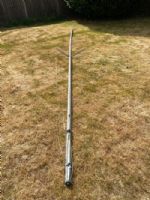Wind Weight |
Post Reply 
|
Page 123> |
| Author | |
Skiffman 
Far too distracted from work 

Joined: 27 May 04 Location: United Kingdom Online Status: Offline Posts: 291 |
 Post Options Post Options
 Quote Quote  Reply Reply
 Topic: Wind Weight Topic: Wind WeightPosted: 17 Nov 05 at 1:24pm |
|
In the 4th November issue of YnY, Andy Rice was talking about wind weights and americas cup. A reader has sent an email in this month explaining that it is not possible, I wondered what other people thought. Myself I think that there is such a thing as wind weight. Because last year the 29er Worlds were in Silvaplana which is 1850m above sea level were the air is less dense and i remember the first day reading 25knots average my anemometer when only felt about 18knots. Get back to the UK doing some winter training at weymouth (-13 degrees windchill) with anemometer reading 18knots when it felt like 25knots. Or am i just stupid and the wind is always the same? Also the reason why the anemometer will read the same wind speed for 2 different air densitys is because the air/paritcles in the air is going that speed but the particles are more spread out in the less dense air so there are less particles hitting your sail even though there hitting it at the same speed therefore it feels like less wind????? what do other people think? I dont really know but find it quite interesting |
|
 |
|
Pierre 
Really should get out more 

Joined: 15 Mar 04 Location: United Kingdom Online Status: Offline Posts: 1532 |
 Post Options Post Options
 Quote Quote  Reply Reply
 Posted: 17 Nov 05 at 3:14pm Posted: 17 Nov 05 at 3:14pm |
|
Good question and I just found this by googling... Wind does not have weight, but the air that wind moves Looks about right to me. The operative word is MASS. Thinner air has less mass. Edited by Pierre |
|
 |
|
Stefan Lloyd 
Really should get out more 
Joined: 03 Aug 04 Online Status: Offline Posts: 1599 |
 Post Options Post Options
 Quote Quote  Reply Reply
 Posted: 17 Nov 05 at 3:56pm Posted: 17 Nov 05 at 3:56pm |
|
At 2000m height the air density is 20% less than at sea level. So you would definitely feel less force in the sails at the same wind speed compared to sea level. The opposite applies to a lesser extent with cold air. If are hardy enough to sail at 3C, the air is 10% denser than on a hot summer day of 30C. So the same wind speed will feel "heavier" in winter. Lots of people claim to observe this but I'm not really certain a 10% difference in force would be that noticeable. The force exerted by the breeze is proportional to the square of the windspeed, so a 5% change in windspeed causes a 10% change in force (more or less). 5% change in windspeed is the difference between 20 and 21 knots, and how many of us would really be able to tell the difference between a steady 20 and 21 knots?
|
|
 |
|
Scooby_simon 
Really should get out more 
Joined: 02 Apr 04 Location: United Kingdom Online Status: Offline Posts: 2415 |
 Post Options Post Options
 Quote Quote  Reply Reply
 Posted: 17 Nov 05 at 10:10pm Posted: 17 Nov 05 at 10:10pm |
|
Ahhhh,
But there is also more to it than this. We don't use the "force" of the air to move us along; we use the pressure difference as a result of the speed differences across the front and the back of the sail(s) (well on most boats anyway) on our boats that creat low pressure that "suck" us along.... Heahache time in terms of actually "calculating" if colder = faster and hotter/higher/thinner = slower..... you never know, you might find that thinner (but faster air) might reward the more skillfull. |
|
|
Wanna learn to Ski - PM me..
|
|
 |
|
CurlyBen 
Really should get out more 
Joined: 17 Aug 05 Location: Southampton Online Status: Offline Posts: 539 |
 Post Options Post Options
 Quote Quote  Reply Reply
 Posted: 17 Nov 05 at 11:24pm Posted: 17 Nov 05 at 11:24pm |
|
Wouldn't denser air have a greater pressure differential anyway though?
|
|
 |
|
Scooby_simon 
Really should get out more 
Joined: 02 Apr 04 Location: United Kingdom Online Status: Offline Posts: 2415 |
 Post Options Post Options
 Quote Quote  Reply Reply
 Posted: 17 Nov 05 at 11:38pm Posted: 17 Nov 05 at 11:38pm |
Yes..... but there was some tongue in cheek Heahache time in terms of actually "calculating" if colder = faster and hotter/higher/thinner = slower..... you never know, you might find that thinner (but faster air) might reward the more skillfull. |
|
|
Wanna learn to Ski - PM me..
|
|
 |
|
CurlyBen 
Really should get out more 
Joined: 17 Aug 05 Location: Southampton Online Status: Offline Posts: 539 |
 Post Options Post Options
 Quote Quote  Reply Reply
 Posted: 17 Nov 05 at 11:46pm Posted: 17 Nov 05 at 11:46pm |
 Oops.. I'm a bit slow today! However
for an identical difference in pressure (I assume this is what you
meant to calculate?) then wouldn't the lower density air have
marginally less drag force on the rig/hull/crew? Can't see that itself
for the variations mentioned would be a huge difference! If that wasn't
the calculation you meant I'll go and sit in the corner.. Oops.. I'm a bit slow today! However
for an identical difference in pressure (I assume this is what you
meant to calculate?) then wouldn't the lower density air have
marginally less drag force on the rig/hull/crew? Can't see that itself
for the variations mentioned would be a huge difference! If that wasn't
the calculation you meant I'll go and sit in the corner..
|
|
 |
|
Stefan Lloyd 
Really should get out more 
Joined: 03 Aug 04 Online Status: Offline Posts: 1599 |
 Post Options Post Options
 Quote Quote  Reply Reply
 Posted: 18 Nov 05 at 7:42am Posted: 18 Nov 05 at 7:42am |
|
And the pressure difference results in a force. Force = pressure x area. No force, no movement (Newton's 2nd law).
|
|
 |
|
Entyplod 
Newbie 
Joined: 24 Nov 05 Location: United Kingdom Online Status: Offline Posts: 4 |
 Post Options Post Options
 Quote Quote  Reply Reply
 Posted: 24 Nov 05 at 6:59pm Posted: 24 Nov 05 at 6:59pm |
|
Stefan Lloyd is pretty much right on this issue:
Wind on a cold day will cause the sails of a boat to provide more force than on a warm one (assuming the atmospheric pressures both days are equal). The confusion lies in both that the difference is not that large, and also in what a cup anemometer is actually measuring. The force exerted by wind on sails is determined by the kinetic energy of the wind; being proportional to the density of the air, times the square of the wind speed. For any given wind speed denser air has greater kinetic energy, and hence gives a greater force on the sails, and vice versa. For a boat the differences are however small. Roughly; for a 3 degree change in temperature (or a 10mb change in pressure) the density of air changes by 1%. Take a 20kt wind on a day that is 20degrees C. On a 5 degrees C day (15 degrees colder) the same air would have a density 5% higher. Hence the cold air would exert the same force as the air on the warm day would if its speed is the square route of 1.05 (i.e. 1.025) times higher – :this gives 20.5kts, not a big difference!! A cup anemometer is trying to measure the speed of the wind, not the force (more correctly the ‘dynamic pressure’) produced by it. Ideally the cups spin at the speed the air flows past them – in reality this does not quite happen due to friction in the anemometer. If you want to measure the force (dybamic pressure) generated by air you need something that works more like an aircraft's air speed indicator. |
|
 |
|
redback 
Really should get out more 

Joined: 16 Mar 04 Location: Tunbridge Wells Online Status: Offline Posts: 1502 |
 Post Options Post Options
 Quote Quote  Reply Reply
 Posted: 24 Nov 05 at 7:56pm Posted: 24 Nov 05 at 7:56pm |
|
An anemometer is measuring the speed of the wind not the force. I'd rather be hit by a fly at 30mph than a car at 30mph. The difference is caused by the mass. It seems perfectly reasonable to me that if we bend wind of greater mass we get greater force even though the wind speed is the same. Now somebody said we'd be unlikely to be able to notice a 10% difference in force - I'd have to disagree. When competing against other boats the difference in performance between boats can be in the order of 50m in a kilometer - about 2%. When you are truly in tune with the boat quite small differences feel quite large, for instance what is the difference between an old jib and a new one - just a couple of seasons use can make the sail feel "off". Finally what difference to the mass is caused by humidity? Heavy wind is often wet wind? |
|
 |
|
Post Reply 
|
Page 123> |
| Forum Jump | Forum Permissions  You cannot post new topics in this forum You cannot reply to topics in this forum You cannot delete your posts in this forum You cannot edit your posts in this forum You cannot create polls in this forum You cannot vote in polls in this forum |
Copyright ©2001-2010 Web Wiz
Change your personal settings, or read our privacy policy









-(1)-202408140552.gif)















 Printable Version
Printable Version Delicious
Delicious Digg
Digg Facebook
Facebook Furl
Furl Google
Google MySpace
MySpace Newsvine
Newsvine reddit
reddit StumbleUpon
StumbleUpon Twitter
Twitter Windows Live
Windows Live Yahoo Bookmarks
Yahoo Bookmarks Topic Options
Topic Options